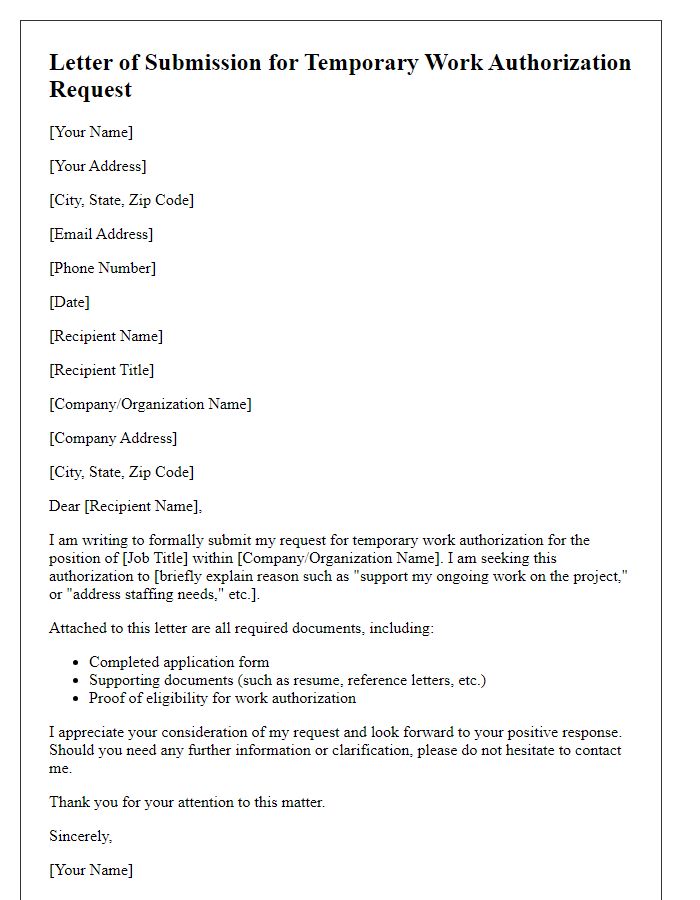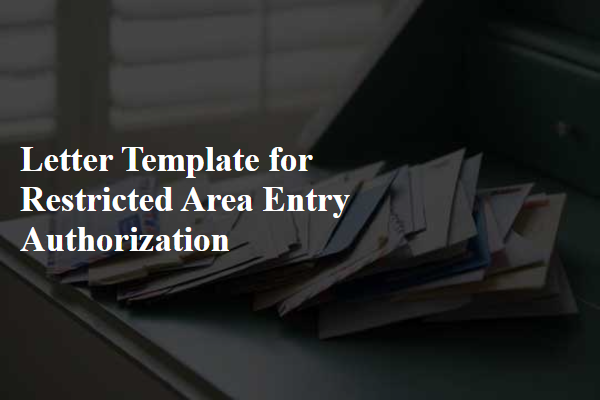Are you navigating the complexities of temporary employment authorization? It can be a daunting process, filled with questions about eligibility, documentation, and timelines. This letter template is designed to simplify your experience, providing a clear framework to get you started. So, let's dive in and explore how you can effectively articulate your needs in your employment authorization request!

Employee and employer details
The temporary employment authorization process requires specific details from both the employee and employer to ensure compliance with local labor laws. An employer's details include the business name, tax identification number, physical address, and contact information. The employee's information should cover their full name, date of birth, nationality, and any relevant identification numbers. Additionally, position title, employment start date, duration of the temporary employment, and the nature of work should be explicitly stated. Essential documentation may include proof of eligibility to work, job description, and any necessary permits related to the specific field or region, ensuring a seamless transition into temporary employment.
Job role and duration
Temporary employment authorization allows individuals to work legally in various job roles for a specified duration. For instance, an individual may receive authorization to work as a Software Developer in a tech company for a period of six months, starting from January 2024 to June 2024. This role may involve tasks such as coding, software testing, and collaborating with team members on project development. The specified duration underscores the temporary nature of the employment, which is often tied to project completion or a specific business need. It is crucial for candidates to ensure compliance with legal requirements to maintain their work status during this authorized period.
Temporary authorization conditions
Temporary employment authorization provides non-citizens the legal ability to work in a specific capacity for a limited duration. Organizations often require this authorization to comply with immigration laws and regulations. Key conditions include valid documentation, such as the Employment Authorization Document (EAD), which specifies the authorized period of work. Employers must verify employment eligibility through the I-9 form, ensuring compliance with federal regulations. This process often involves periodic renewals depending on the individual's visa status, including H-1B or F-1 categories, which dictate specific employment guidelines. Failure to adhere to these conditions can lead to penalties for both employers and employees.
Legal and compliance statements
Temporary employment authorization for non-immigrant workers allows individuals to engage in gainful employment while adhering to local labor laws and regulations. Organizations must ensure compliance with U.S. Citizenship and Immigration Services (USCIS) guidelines as outlined in the Form I-765 (Application for Employment Authorization). Categories include asylum seekers, students, and individuals under Temporary Protected Status (TPS), each with specific eligibility criteria and documentation requirements. Employers must maintain accurate records of employment eligibility and ensure completion of Form I-9 (Employment Eligibility Verification) for all employees, safeguarding against unauthorized employment practices. Non-compliance can result in substantial penalties, including fines and loss of the ability to sponsor future employment visas. Staying informed about changes in immigration laws is crucial for legal safety and operational integrity within hiring processes.
Signature and date lines
Temporary employment authorization documentation often requires a clear delineation of responsibility and acknowledgment. The signature line typically includes space for the authorized individual's name, title, and signature, affirming their consent and approval. The date line conveys when the agreement was finalized, providing a specific timeline for the start and term of employment. Such documentation may be required by regulatory bodies such as the U.S. Citizenship and Immigration Services (USCIS) or similar entities in various jurisdictions, highlighting the importance of clarity and compliance in the employment process.
Letter Template For Temporary Employment Authorization Samples
Letter template of follow-up for temporary employment authorization status













Comments